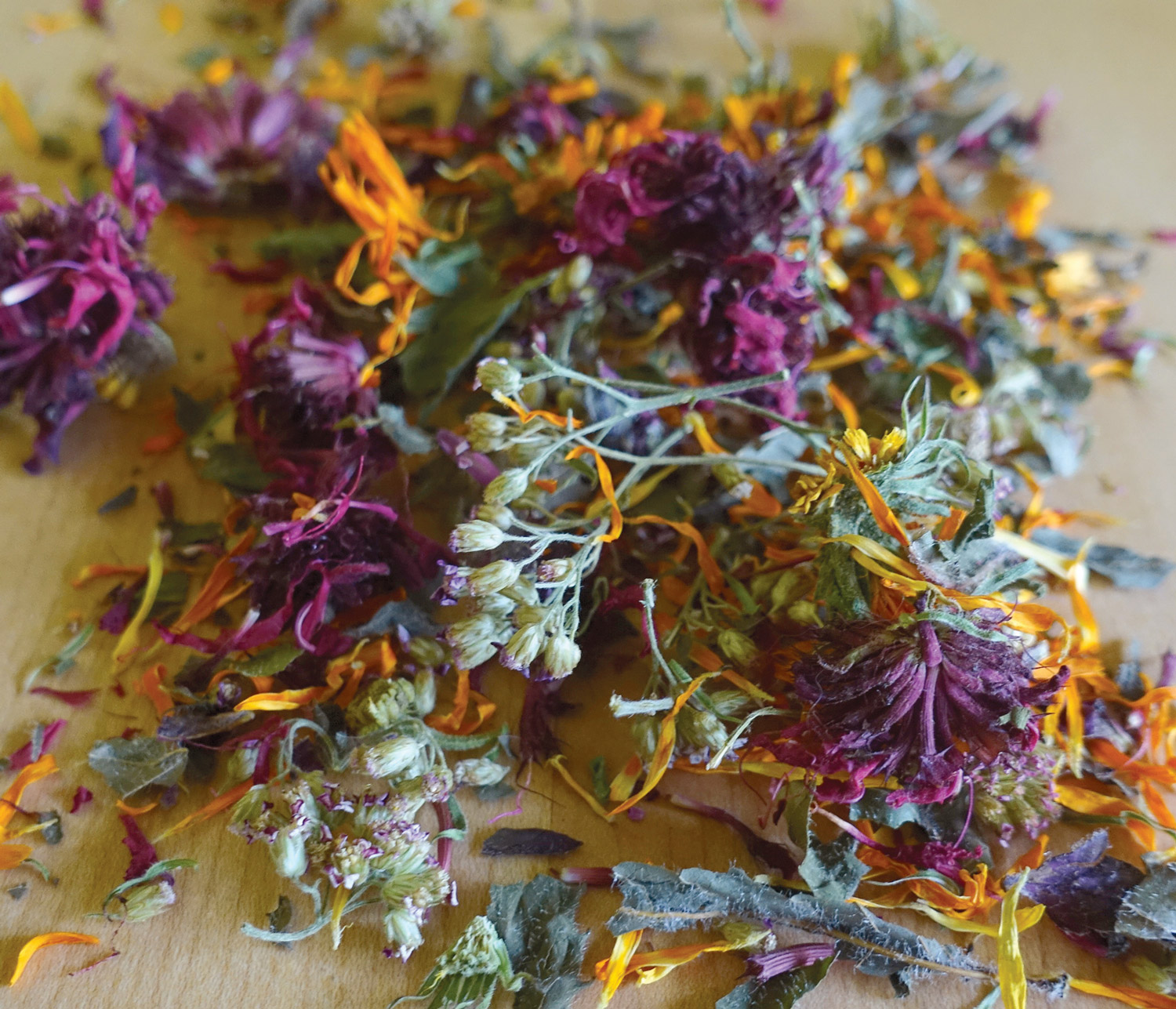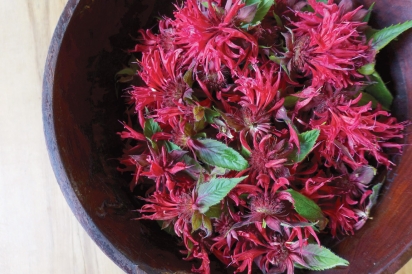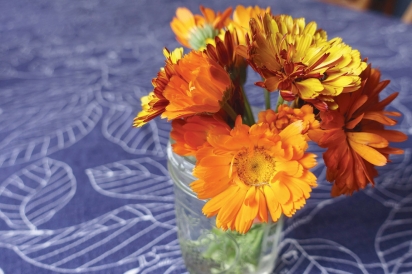Greetings from Your Garden
Bringing Bee Balm, Calendula and Yarrow into Your Kitchen
It’s that time of year again. The cold season has arrived, bringing with it cozy-sweater mornings and fireside evenings. Days spent clomping through fresh snow searching for animal tracks, and quiet walks along the blustery shoreline. It is the perfect time to sip from mugs of steamy cocoa, bake up some pies, and hunker down for a while with our loved ones. It is also the perfect time to plan out our spring gardens.
It might seem like an anachronistic point on the calendar to think about all things green and growing, but we plant lovers know full well that winter isn’t just a time for putting our gardens to bed and taking a break. Winter, for those of us that love the scent of soil and the sight of new shoots pushing out of the earth, is also the exciting time to decide what we will grow next year.
Seed catalogues offer a seemingly endless, rainbow-hued array of annual and perennial options. The choices can seem overwhelming when considering what plants to add to your own growing spaces, and there are countless factors that go into deciding what we grow, and why we choose to grow it.
As someone who doesn’t enjoy fighting with their garden and is an emphatic food enthusiast, I am a champion of unfussy, hardy plants that are both beautiful and can also be featured prominently in my kitchen. My own gardening leans heavily toward plants that offer a variety of edible parts, don’t need a ton of intervention, and bring lush foliage or colorful blooms into my growing spaces.
The list of plants in this category is an extensive one, and some are more familiar to us than others. In fact, you may already be growing plants that could be serving double-duty in your mugs and bowls without you knowing it. For every inedible ornamental, there is a nasturtium plant or lilac bush just waiting for you to discover its culinary potential.
So as you peruse the glossy pages of seed catalogues and the aisles of your favorite garden stores over the next few months, consider adding these visually dynamic multi-purpose plants to your spring lineup.
Hello, my name is Bee Balm:
Bee balm (Latin name, Monarda) is a tall, eye-catching member of the mint, or Lamiaceae, family. Boasting tufts of small, tubular flowers that are often mistaken for a single large bloom, bee balm’s unique flowers look equally at home in our yards as they would on a newly discovered alien planet. The flowers are most commonly seen in shades of reds, pinks, purples, and whites, but the vibrant magenta blossoms are my favorite. This useful, hardy perennial provides us with two distinct edible parts that can be used throughout the growing season, and is great at attracting our native pollinators.
Like with so many plants within the expansive mint family, bee balm’s fragrant leaves and flowers can be used either fresh or dried as a culinary herb or steeped tea. The flavor profile of bee balm leaves reminds me of that other mint-family member oregano, and I use it in many of the same ways I would use that related plant. I love to add a handful of bee balm leaves into a simmering pasta sauce, or finely chop some up and sprinkle it over a homemade pizza. The milder-tasting flowers are reminiscent of the Bergamot orange, the essential oil of which is used as an ingredient in Earl Grey teas. Due to this similarity, bee balm is often also called wild bergamot, and is one of my favorite ingredients in tea blends, as well as recipes featuring citrusy elements. The delicate individual flowers work particularly well sprinkled atop a lemon cake, mixed into a fruit sorbet, or added into a summery salad with orange slices.
Hello, my name is Calendula:
Few flowers feel quite as cheerful and warm to me as those of the calendula plant (Calendula officinalis). In my mind, the sunny, daisy-like blossoms are the quintessential flower in the same way that a Golden Retriever is the quintessential dog. Ask a kindergartener to draw a flower, and the result will likely resemble the disk-and-ray shape of this lovely addition to our garden bed. While calendula can be grown in a wide variety of shades, it is the trademark solid yellow or solid orange versions that epitomize the blooms in my mind, and that I prefer to include in recipes. This hardy annual plant has it all — it can deal with colder temperatures, will self-seed vigorously, and provides us with an edible flower that has been prized for its medicinal healing properties for centuries.
I use whole calendula flowers throughout the growing season in my jars of sun tea alongside dandelion blossoms (both plants are members of the Asteraceae family) and lemon balm leaves. I will also throw individual petals in salads, press them into the tops of sugar cookies, and stir them into rice dishes. In each recipe the petals add a mild floral flavor and a bright pop of color to my table. I also dry calendula flowers and include them in herbal tea blends, homemade salves, and lip balms, since the flowers are widely valued for their topical and internal healing properties.
Hello, my name is Yarrow:
For my money there is no prettier leaf structure than that of yarrow. The delicate, feather-like compound leaves look like tiny ferns that would be right at home in a museum of miniatures. Conveniently, yarrow’s Latin name, Achillea millefolium, lays out some of the plant’s most notable characteristics. Achillea references the mythical Greek character Achilles, who legend says used the revered medical plant as a healing salve for his men. Millefolium, meanwhile, describes the particular, many-sectioned structure of the yarrow’s foliage as “thousand-leaved.” Yarrow is an industrious perennial grower, and will happily spread beyond its original home. Since I love the plant so much, I don’t mind when I end up with larger patches of yarrow each year, but take care about your growing location if you’d like it to stay put. Cultivated versions of yarrow bear clusters of tiny flowers that come in Easter-egg shades of yellows, reds, pinks, and white, while the wild version of yarrow that appears along roadsides and in disturbed soil most commonly bears white flowers.
Of all of the plants I grow, yarrow might be the one I most frequently use for hot tea, though I will also use the leaves in savory recipes that call for rosemary or sage, as those are the flavors to which I can most reasonably compare them. Think autumnal stuffings and roasted fish or poultry. I have also used yarrow leaves as an herbal addition to caramelized onions and found it to be a perfect pairing. The dense flowers are too tough to use in recipes fresh, but they are on the short list of favorites when it comes to mixing up herbal tea blends. As a tea infusion, I find that the flavor of yarrow — both the leaves and flowers — is a great match for most of the other herbs in my cabinet, with the possible exception of peppermint or anise hyssop (though I am sure there are plenty of folks out there who disagree with me on that point). The tiny dried flowers and lacey leaves also look beautiful alongside other tea ingredients, making jars of these custom tea blends great holiday gifts.








